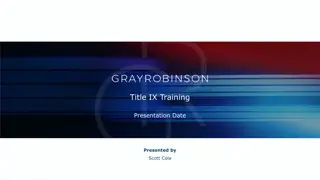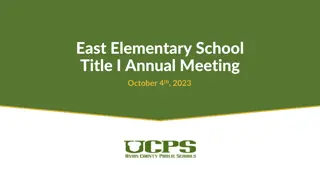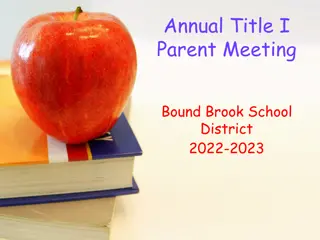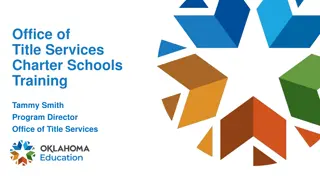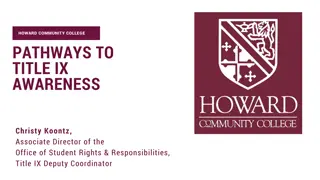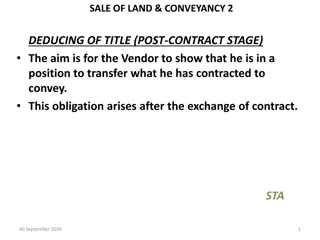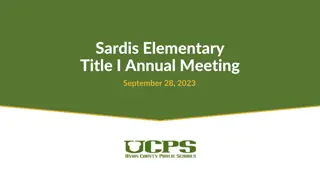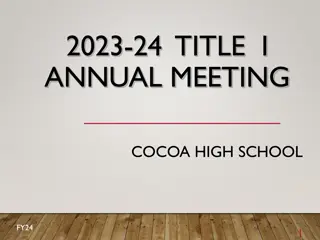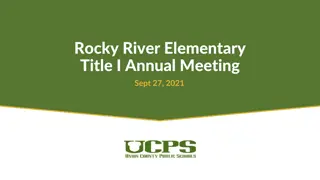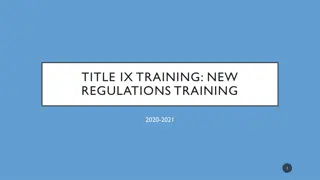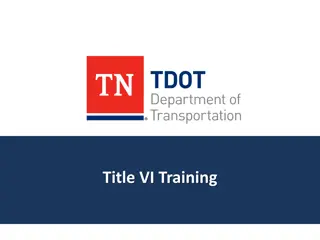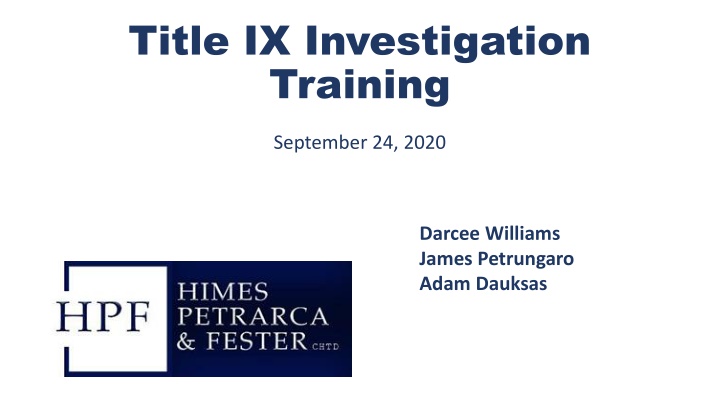
Title IX Regulations and Obligations in Education Programs
Explore the key aspects of Title IX, regulations effective August 14, 2020, and how it prohibits sexual harassment within educational programs. Learn about the obligations for Federal funds recipients, including school districts, regarding athletics, discipline, and sex-based harassment.
Download Presentation

Please find below an Image/Link to download the presentation.
The content on the website is provided AS IS for your information and personal use only. It may not be sold, licensed, or shared on other websites without obtaining consent from the author. If you encounter any issues during the download, it is possible that the publisher has removed the file from their server.
You are allowed to download the files provided on this website for personal or commercial use, subject to the condition that they are used lawfully. All files are the property of their respective owners.
The content on the website is provided AS IS for your information and personal use only. It may not be sold, licensed, or shared on other websites without obtaining consent from the author.
E N D
Presentation Transcript
Title IX Investigation Training September 24, 2020 Darcee Williams James Petrungaro Adam Dauksas
Title IX: What is it? Explained: Title IX of the Education Amendments of 1972 provides that No person in the United States shall, on the basis of sex, be excluded from participation in, be denied the benefits of, or be subjected to discrimination under any education program or activity receiving Federal financial assistance. Key areas where Federal funds recipients, including school districts, have Title IX obligations: athletics, discipline, and sex-based harassment. OCR enforces Title IX compliance. 2
Title IX Regulations Effective August 14, 2020 Changes to Formal Complaints Prescribed investigation/grievance processing Written notices Evidence disclosures Impartiality in investigation Appeal options Informal resolution opportunities Mandatory staff training Website Posting 3
Title IX Prohibits Sexual Harassment Within Educational Program Defined: District employee conditions the provision of an aid, benefit, or service on an individual s participation in unwelcome sexual conduct (quid pro quo) Unwelcome conduct determined by a reasonable person to be so severe, pervasive and objectively offensive that it effectively denies a person equal access to the District s educational program or activity (hostile environment) Sexual assault, dating violence, domestic violence, stalking as defined by federal statutes. 4
Title IX Prohibits Sexual Harassment: Relevant Federal Statutes Sexual assault means an offense classified as a forcible or nonforcible sex offense and includes rape, fondling, incest, and statutory rape. 20 U.S.C. 1092(f)(6)(A)(v); 34 C.F.R. Part 668, Appendix A to Supbart D. Dating violence means violence committed by a person: (1) who is or has been in a social relationship of a romantic or intimate nature with the victim, and (2) where the existence of such a relationship shall be determined based on a consideration of the length of the relationship, the type of relationship, and the frequency of interaction between the persons involved in the relationship. 34 U.S.C. 12291(a)(10). Stalking means engaging in a course of conduct directed at a specific person that would cause a reasonable person to: (1) fear for his or her safety or the safety of others, or (2) suffer substantial emotional distress. 34 U.S.C. 12291(a)(30). See Policy 2:265-E 6
Consent Defined in 2:265E Knowing, voluntary, and clear permission by word or action, to engage in mutually agreed upon sexual activity. May not be inferred from silence, passivity, or a lack of verbal or physical resistance. A person s manner of dress does not constitute consent. Past consent to sexual activity or a dating relationship does not imply ongoing or future consent. Consent to some sexual contact (kissing) does not presume consent for other (e.g., intercourse). Consent to engage in sexual activity with one person does not constitute consent to engage in sexual activity with others. 7
Consent Defined in 2:265E Consent may be withdrawn at any time. A person cannot consent to sexual activity if that person is unable to understand the nature of the activity or give knowing consent, e.g.,: Under the influence of alcohol or drugs; Asleep or unconscious; Under age; or Incapacitated due to a mental disability. The existence of consent is based on the totality of the circumstances, including the context of the incident. 8
Investigation/Grievance Processing District must have a written policy defining the complaint and grievance process PRESS Policy 2:265 (new): Title IX Sexual Harassment Grievance Procedure 9
Grievance Process: Investigators Grievance Process: Roles 1) Final Decision-Maker: Final reviewer of matter; no original work 2) Initial Decision-Maker: Writes the decision 3) Title IX Coordinator: Coordinates the investigation, can be investigator 4) Investigator: Accepts evidence and interviews; prepares investigation report Who should investigate? Regulations require that: The Decision-Maker (initial or appeal) shall not be the Title IX Coordinator or the investigator Each party is entitled to appeal the initial decision-maker s ruling. 10
Grievance Process: Roles A. Superintendent B. Board 1. Superintendent (Final decision-maker) 2. HR Admin (Initial decision-maker) 3. Student Svcs. Admin. (Title IX Coordinator/Investigator/Facilitator) 4. Other Dist. Admin. (Investigator/Facilitator) 1. Board Committee (Final decision-maker) 2. Superintendent (Initial decision-maker) 3. Asst. Supt. Student Svcs. (Title IX Coordinator/Investigator/Facilitator) 4. Other Admin. (Investigator/Facilitator) C. Third Party/Small District Consider 1. Neighboring Supt. (Final decision-maker) or Hearing Officer-type individual 2. Superintendent (Initial decision-maker) 3. Administrator (Title IX Coordinator/ Investigator/Facilitator) 4. Administrator (Investigator/Facilitator) Assigning two administrators to serve as investigators/facilitators is recommended: Consider gender balance One to investigate, the other to facilitate resolution in any given case Supt. cannot serve as Decision-Maker if Respondent is the Supt. or a Board Member 11
Formal Complaint District s duty to investigate sexual harassment under Title IX is triggered when a formal complaint is filed alleging sexual harassment within the District s educational program Anyone can report sexual harassment, but a formal complaint can only be filed by: (1) The alleged victim of sexual harassment (or minor s parent); (2) The District s Title IX Coordinator. Formal complaint must be in writing and signed (digital signatures permitted; email would be sufficient) Form Formal Complaint Template 12
After a Report is Filed: Intake Meeting Whether a formal complaint is filed or just a report that may lead to a formal complaint, the following actions must be performed by the Title IX Coordinator: (1) Discuss the availability of supportive measures with the alleged victim, while considering his/her wishes; and (2) Explain the process for filing a Formal Complaint Form Notice of Complaint Process and Supportive Measures Notice to Complainant of Informal Report 13
After a Report is Filed: Supportive Measures for Both Parties Examples of supportive measures include: Any supportive measures implemented must be kept as confidential as possible. Counseling, social worker visits Deadline extensions Schedule, class, transportation modifications Regular check-ins; escorts Increased security/monitoring Mutual contact restrictions Responsibility for ensuring supporting measures are implemented falls on the Title IX Coordinator. 14
After a Formal Complaint is Filed: Preliminary Considerations If a Formal Complaint is filed, the claim must be investigated. However: If the allegations: (1) do not meet the definition of sexual harassment, or (2) is not within the educational program, or (3) did not occur within the United States, the formal complaint must be dismissed by the Title IX Coordinator. Hostile environment claims are fact-specific and may require investigation before dismissal Coordinator may dismiss if: (1) Respondent is no longer enrolled/employed; (2) Complainant requests withdrawal; or (3) Absence of sufficient evidence Form Dismissal of Formal Complaint 15
After a Formal Complaint is Filed: Jurisdiction Scope of Educational Program includes all locations, events or circumstances in the United States over which the District exercises substantial control over the Parties - Can include off-campus events (e.g., extracurricular events) - Can include digital platforms, particularly if the platform is owned, operated or used for District operations. 16
After a Formal Complaint is Filed: Preliminary Considerations Interplay with Other Complaint Policies If the allegations are not covered by Title IX, consider referring the complaint for review/investigation under other forums: uniform grievance; bullying; harassment; student code of conduct If the allegations are covered by Title IX and the grievance process of Policy 2:265, are there other Board policies and steps therein to also consider, such as: Mandated reporting (5:90) Bullying prevention (7:180) Student behavior (7:190) 17
After a Formal Complaint is Filed: Preliminary Considerations Emergency Removal of Respondent The Title IX Coordinator must make a preliminary determination whether it is appropriate to make an immediate removal of the Respondent from the school. If student: must first consider whether the Respondent presents an immediate threat to the health or safety of Complainant or other student. If so, consider alternative placements or suspension. If employee: consider administrative leave 18
Grievance Process: Notice to Parties After Formal Complaint is filed, issue notices to parties (Complainant and Respondent) to include: (1) Grievance process disclosure (Policy 2:265) (2) Outline of material allegations (who; what; when; where) - Amend if new material allegations arise during investigation (3) Presumption of non-responsibility (4) Opportunity to submit and review evidence; questions (5) Entitlement to advisor of choice (6) Consequences of false statements (7) Code of conduct (8) Informal resolution options Form: Notice of Complaint Process (Complainant and Respondent) 19
Grievance Process: Informal Resolution Districts are permitted to offer and facilitate informal resolution options, e.g., mediation or restorative justice Both parties must give voluntary, informed and written consent Requires issuance of Formal Complaint before proceeding Allowed at any point during grievance process Must permit withdrawal from Informal Resolution process Not permitted where Formal Complaint alleges employee sexual harassment of student Form Informal Resolution Consent Notice of Availability of Informal Resolution 20
Grievance Process: Informal Resolution (1) Who facilitates? To maintain fairness and impartiality of investigation, have other investigator act as resolution facilitator (2) Consider confidentiality provision for resolution agreement (3) Memorialize resolution in writing and include waiver of grievance process Form Informal Resolution Agreement Template 21
Grievance Process: Hallmarks (1) Equitable treatment of parties a. Supportive measures and remedies for both Parties b. Presumption of non-responsibility, grievance process for Respondent c. Same/fair opportunities to submit evidence, statements, etc. (2) Impartiality of all involved (3) Process before sanctions (4) Appeal rights for both Parties (5) Timeline: reasonably prompt. PRESS = 90 business days (District office) (6) Notice: Parties are to be given advance notice of any participation (investigatory meetings; submissions; hearings; etc.) and reasonable opportunity to prepare 22
Grievance Process: Standard of Proof Title IX regulations allow Districts to adopt one of two standards of proof in the grievance process (2:265-AP2): Preponderance: the greater weight (PRESS default) Clear and convincing: highly probable or reasonably certain One standard must be used for all sexual harassment complaints. 23
Investigation: Evidence Evidence: Something (including testimony, documents and tangible objects) that tends to prove or disprove the existence of an alleged fact. (Black s Law Dictionary, 2nd Ed.). - Statements; photos; recordings; text messages; call logs Inculpatory evidence: tending to show responsibility for allegation Exculpatory evidence: evidence suggesting lack of responsibility Evidence is used to make credibility determinations among conflicting witnesses. - Credibility determinations cannot be made based upon the individual s party status (e.g., Complainant; Respondent) nor should be based on stereotypes, biases, etc. (e.g.; jocks; rumors; academic standing) 25
Grievance Process: Evidence A party s sexual predisposition or prior sexual behavior is typically not relevant to the allegations of a complaint. Exceptions (1) When offered to prove that someone other than the Respondent committed the conduct alleged by the complainant, or (2) If the questions and evidence concern specific incidents of the complainant's prior sexual behavior with respect to the Respondent and are offered to prove consent. 26
Grievance Process: Evidence Medical/treatment records of a party cannot be used by investigator unless the party provides voluntary, written consent Be careful not to access these records from the student s file without the proper consent 27
Grievance Process: Optional Hearing While an adversarial hearing is mandatory at the higher education level, it is at the District s discretion at the K-12 level. If you are considering whether to provide a hearing option to the Parties, please contact your attorney to discuss the pros/cons of that process. 28
Grievance Process: Discovery Prior to the close of the investigation, the investigator shall provide to both parties any directly related evidence so that each party can meaningfully respond before the investigatory report is prepared. Electronic or hard copy disclosure is permitted. Parties then must be provided at least 10 school business days to submit a written response for the investigator s consideration. If a party submits a response, the investigator shall provide a copy to the other party. Form Notice of Opportunity to Submit Written Responses to Evidence 29
Grievance Process: Investigatory Report After all interviews and evidence submissions are completed, the investigator must create an investigative report that summarizes the relevant evidence. Recommendation: credibility determination The report must be sent to the party and advisor electronically Maintain confidentiality wherever possible Each party shall have at least 10 school business days to submit a written response to the Initial Decision-Maker How does the investigator know when to close the investigation? Form Template for Investigative Report Notice of Investigative Report 30
Investigations are hard. When people see the final product wrung from the mind and heart of an artist or writer or entrepreneur, they often under- appreciate the effort behind it. ... The layperson sees the destination, not the journey. The same can be true of investigations. There s a ready pop-culture phrase to describe how investigations should be done, suggesting it is an easy exercise. Just connect the dots, people say. The idea that you can always get to the truth through a technique we teach kindergartners has always been puzzling to me. ...There s no foolproof guide or order, no guarantee that any of the work that you re doing dragging not a crayon across a page but your feet all over town interviewing witnesses, issuing subpoenas, looking into financial documents will yield a clear, accurate, and actionable picture. Preet Bharara, former U.S. Attorney for the Southern District of New York (excerpted from Doing Justice: A Prosecutor s Thoughts on Crime, Punishment and the Rule of Law (2019)) 31
Grievance Process: Transition to Initial Decision-Maker Once the Investigator s report is prepared, the following is transmitted to the Initial Decision-Maker 1. Formal Complaint 2. All evidence gathered that is directly related to the allegations (even if discounted/dismissed) 3. Investigative Report 32
Grievance Process: Mandatory Questions to the Initial Decision-Maker The Initial Decision-Maker must review all materials received from investigator and: 1. Provide Parties with written notice of the opportunity to submit written, relevant questions asked of any party/witness. PRESS recommends that the Notice inform parties of the relevance/non-relevance of the Complainant s sexual predisposition or prior sexual behavior 5-day (school business days) timeline to submit questions. 2. Forwards questions to other party for response If any questions are rejected as non-relevant, must provide the requesting party with a written explanation of the decision to exclude. 3. Upon receipt of answers, forwards copy to the requesting party. 4. Provides opportunity for limited, follow-up questions for submission within five days of notice. Form Notice of Party Questions Opportunity, Notice of Party Questions for Response, Notice to Parties of Answers, Notice of Limited Follow-Up Questions, Notice to Parties of Answers to Limited Follow-Up Questions, Notice of Excluded Question(s) 33
Written Decision and Notice The Decision is to be provided to the Parties simultaneously and include: 1. Summary of allegations constituting Title IX claim 2. Procedural history summary (notices; interviews; summary of testimony) 3. Findings of fact (based on the standard of proof) 4. Conclusions regarding the application of the District s anti-harassment policies and rationale for conclusions; 5. Determination of responsibility 6. Sanctions/discipline against Respondent (if any) 7. Remedies to Complainant (if any) 8. Appeal rights Form: Decision Template 34
Appeal Rights Within 10 school business days after receiving either: (1) a dismissal notice from the Title IX Coordinator; or (2) an adverse decision from the Initial Decision-Maker, a party may make a written request to the Title IX Coordinator to appeal the matter based on: (1) Procedural defect affecting the outcome; (2) New evidence that could reasonably affect the outcome but not available at the time of the determination; (3) Conflict of interest or bias of the Coordinator, Investigator or Initial Decision-Maker affecting the outcome. Additional bases for the appeal may be offered to all parties, but are not required. 35
Appeal Rights If an appeal is submitted, the Title IX Coordinator: (1) Notifies the other party (and should send a copy of the appeal); (2) Provides both parties 5 school business days to submit a written statement in support of, or challenging, the appeal; (3) Forwards all investigatory materials, decisions and appeal records to the Appellate Decision-Maker Appellate Decision-Maker has 30 school business days to affirm, reverse or amend the Written Decision or the Dismissal with explanatory rationale and notify the Parties in writing. Form Notice of Appeal Template for Appellate Decision-Maker Report 36
District Liability for Improper Complaint Processing School Districts have a mandatory obligation to promptly respond and investigate allegations in a manner that is not deliberately indifferent - Was the District s response clearly unreasonable? - Did the District exercise conscious disregard of the allegations? Significant departure from grievance processing regulations (this training) and the District s implementing policy are difficult to defend 37
Recordkeeping/Transparency District must maintain investigative file and decisions for 7 years Must post the following on website Contact information for Title IX Coordinator Non-discrimination policy Training materials 38
Grievance Process: Miscellaneous Timeline: Can be extended with written notice to parties demonstrating good cause, such as: Party (or advisor) absence Witness absence Concurrent law enforcement action Disability/language accommodation 39

